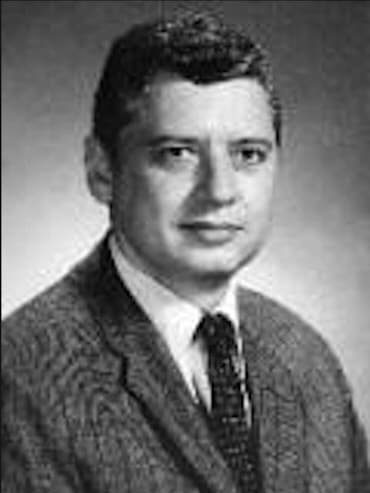Hillel J. Gitelman

Hillel Jonathan Gitelman (1932-2015) was an American nephrologist
Gitelman was a nephrologist best known for identifying the familial renal disorder now known as Gitelman syndrome. A graduate of Princeton University and the University of Rochester Medical School, Gitelman trained in internal medicine at Duke University, followed by research at the NIH and a nephrology fellowship at the University of North Carolina.
Gitelman syndrome is now recognised as a common autosomal recessive disorder affecting the distal convoluted tubule, leading to hypokalaemia, hypomagnesaemia, hypocalciuria, and metabolic alkalosis, a profile mimicking thiazide diuretics. Gitelman’s delineation of biochemical, clinical, and histologic features distinguished it from Bartter syndrome. The gene responsible (SLC12A3) was later identified, confirming his early observations and enabling genetic diagnosis.
Beyond his eponymous contribution, Gitelman pursued research into calcium, phosphate, and bone metabolism, particularly aluminium-related osteodystrophy in dialysis patients. He was known as a thoughtful clinician-scientist and a mentor to generations of nephrologists at UNC. After retiring in the mid-1990s, he continued to be recognised for his contributions to renal medicine.
Biographical Timeline
- 1932 – Born December 23, in Rochester, New York, son of Jacob Gitelman (judge and lawyer) and Belle Gitelman (artist and concert pianist).
- 1949 – Graduated from Monroe High School, Rochester NY. Awarded scholarship to Princeton University.
- 1954 – Graduated AB, Princeton University.
- 1958 – Graduated MD, University of Rochester Medical School.
- 1960 – Completed internal medicine residency at Duke University. Commenced research fellowship at the National Institutes of Health (NIH).
- 1962 – Nephrology fellowship at University of North Carolina School of Medicine, Chapel Hill.
- 1966 – Described a novel familial kidney disorder involving hypokalaemia and hypomagnesaemia in two sisters, later known as Gitelman syndrome.
- 1970s–1990s – Continued research in nephrology and bone metabolism, including studies on aluminium-related bone disease and calcium-magnesium-phosphate homeostasis.
- 1990s – Gene responsible for Gitelman syndrome (SLC12A3) cloned by his group at the time of his retirement.
- 1995 – Retired after a 30-year career at UNC, Chapel Hill.
- 2015 – Died January 12, aged 82 at Carolina Meadows, Chapel Hill, NC, from complications of Parkinson’s disease.
Medical Eponyms
Gitelman Syndrome (1969)
Gitelman syndrome affects the distal convoluted tubule, where a defect in the Na⁺-Cl⁻ cotransporter (SLC12A3) leads to hypokalaemia, metabolic alkalosis, hypomagnesaemia, and hypocalciuria, mimicking the action of thiazide diuretics.
Gitelman syndrome is an autosomal recessive renal tubulopathy characterised by hypokalaemia, hypomagnesaemia, hypocalciuria, and metabolic alkalosis, with normal or low blood pressure. It affects the distal convoluted tubule, mimicking the action of thiazide diuretics. First described by Hillel Gitelman in 1966 and genetically defined in the 1990s, it is now recognised as one of the most common inherited salt-wasting disorders.
1966 – Original description by Gitelman HJ, Graham JB, and Welt LG. published as A familial disorder characterized by hypokalemia and hypomagnesemia. Gitelman’s team documented clinical and biochemical features distinguishing the disorder from Bartter syndrome. Their patients had low urinary calcium and no juxtaglomerular hyperplasia, setting the stage for recognition of a distinct renal salt-handling defect.
The syndrome presented in two sisters revealed consistent electrolyte abnormalities — notably hypokalaemia and hypomagnesaemia — without significant renal sodium wasting or hypertension.
Gitelman, 1966
Comparative Context:
Comparison of Bartter, Gitelman and Liddle syndromes
| Feature | Bartter Syndrome | Gitelman Syndrome | Liddle Syndrome |
|---|---|---|---|
| Defect location | Thick Ascending Limb of Loop of Henle | Distal Convoluted Tubule | Collecting Duct (ENaC channel) |
| Transporter affected | NKCC2 (Na⁺-K⁺-2Cl⁻ cotransporter) | Na⁺-Cl⁻ cotransporter (SLC12A3) | Epithelial Na⁺ Channel (ENaC; SCNN1B/SCNN1G) |
| Pathophysiologic mimic | Loop diuretics (lose Ca²⁺) | Thiazide diuretics (preserve Ca²⁺) | Aldosterone excess (but low aldosterone) |
| Serum potassium (K⁺) | ↓ Hypokalaemia | ↓ Hypokalaemia | ↓ Hypokalaemia |
| Serum bicarbonate (HCO₃⁻) | ↑ Metabolic alkalosis | ↑ Metabolic alkalosis | ↑ Metabolic alkalosis |
| Serum magnesium (Mg²⁺) | Normal or mildly ↓ | ↓ Hypomagnesemia | Normal |
| Urinary calcium | ↑ Hypercalciuria | ↓ Hypocalciuria | Normal |
| Blood pressure | Normal or low | Normal or low | ↑ Hypertension |
| Renin | ↑ Elevated | ↑ Elevated | ↓ Suppressed |
| Aldosterone | ↑ Elevated | ↑ Elevated | ↓ Suppressed |
| Age of onset | Neonatal/Childhood | Childhood/Adolescence | Childhood/Adolescence |
| Response to treatment | NSAIDs (↓ prostaglandins), K⁺, spironolactone | Mg²⁺ and K⁺ supplementation, ± NSAIDs | Amiloride or triamterene (ENaC inhibitors) |
Major Publications
- Gitelman HJ, Graham JB, Welt LG. A new familial disorder characterized by hypokalemia and hypomagnesemia. Trans Assoc Am Physicians. 1966;79:221-35. [Gitelman syndrome]
- Gitelman HJ, Kukolj S, Welt LG. The influence of the parathyroid glands on the hypercalcemia of experimental magnesium depletion in the rat. J Clin Invest. 1968 Jan;47(1):118-26.
- Gitelman HJ, Graham JB, Welt LG. A familial disorder characterized by hypokalemia and hypomagnesemia. Ann N Y Acad Sci. 1969 Aug 15;162(2):856-64.
- Bello VA, Gitelman HJ. High fluoride exposure in hemodialysis patients. Am J Kidney Dis. 1990 Apr;15(4):320-4.
References
Eponymous terms
- Cruz DN, Shaer AJ, Bia MJ, Lifton RP, Simon DB; Yale Gitelman’s and Bartter’s Syndrome Collaborative Study Group. Gitelman’s syndrome revisited: an evaluation of symptoms and health-related quality of life. Kidney Int. 2001 Feb;59(2):710-7.
- Unwin RJ, Capasso G. Bartter’s and Gitelman’s syndromes: their relationship to the actions of loop and thiazide diuretics. Curr Opin Pharmacol. 2006 Apr;6(2):208-13.
- Knoers NV, Levtchenko EN. Gitelman syndrome. Orphanet J Rare Dis. 2008 Jul 30;3:22.
- Graziani G, Fedeli C, Moroni L, Cosmai L, Badalamenti S, Ponticelli C. Gitelman syndrome: pathophysiological and clinical aspects. QJM. 2010 Oct;103(10):741-8.
Eponym
the person behind the name
BA MA (Oxon) MBChB (Edin) FACEM FFSEM. Emergency physician, Sir Charles Gairdner Hospital. Passion for rugby; medical history; medical education; and asynchronous learning #FOAMed evangelist. Co-founder and CTO of Life in the Fast lane | On Call: Principles and Protocol 4e| Eponyms | Books |
